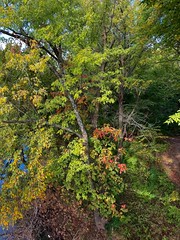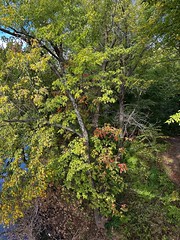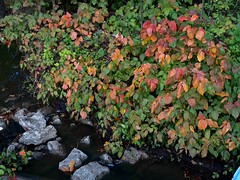SEE THE PERMANENT “ALL MY CAMERAS” PAGE FOR A CONTINUOUSLY UPDATED RECORD OF MY CAMERAS OVER THE YEARS
December 12, 2009
While I’ve used cameras for years, only since my second trip to the Pacific Northwest in 2005 have I paid much attention to taking quality landscape photographs. I’ve already documented the computers I’ve used over the years, and now will look back at the still-photograph cameras of my past.
I grew up with photographs, although they were always small snapshots. My earliest experience with a snapshot camera was my parents’ Kodak Instamatic X-15 with its “126” film cartridges and rotating flash cube. It shot a 26.5 mm square on-film image. About 10 million cameras used that film format, but it is now extinct.
The camera was extremely simple to operate – you just looked through the viewfinder and pushed a lever. If you thought you might need flash, you popped in a flash cube and it would explode one of its four bulbs, rotating for the next shot. After taking a shot you had to shove a spring-loaded lever on its back a couple of times to advance the film. Sometimes you forgot, and that created interesting double-exposed images. Of course, you might not know that for weeks or months, depending on when you finally sent in the film to be developed – and we didn’t have one-hour photo processing back then.
My own first camera was a bulky used Polaroid unit we had inherited. It took dreadful pictures which literally stank – from the chemicals used for its instant pictures. It was definitely not a case of instant gratification, however, as most of its output was sickly green shots with brown smears, and none were worth keeping or even looking at. Some of my relatives loved taking Polaroids, but I never cared for them.
I took a one-semester photography class in junior high, and for that occasion received my own Kodak Ektralite unit. It took poor point-and-shoot pictures on “110” film cartridges, but at least it had a built-in flash instead of the rotating flashcubes. Its pitiful 13 x 17 mm on-film images did not hold a candle to the fancy 35 mm single lens reflex camera they had at school. But even when I used the school camera, my photography was utterly uninspired.
Our photography classroom had chalkboards on three walls, and the coach who taught the class often already had them filled with notes when we walked in. I remember writing down the notes from one set of boards, rotating my seat to face another wall and copy down more notes, and then rotating again to copy down the third wall of notes. The only real fun was when we’d get our turn to work in the dark room with the chemical baths and enlarger. So at least we got to develop contact sheets and some black-and-white prints. Our end-of-year project was an 8×10 print, and my choice to shoot a garbage can in the school corridor was a mixture of rebellion and apathy.
I took the 110 with me on a trip to Washington, DC in 1984, and afterward noticed how awful its prints looked. So I bought a cheap 35 mm point-and-shoot to replace it. The new camera did much better on vacations, and I did manage to take one great photograph with it, of wildflowers in the Wichita Mountains Wildlife Refuge near Lawton. But now I can’t even recall what brand of camera it was. I used it sparingly for about a decade of vacation snapshots.
The late 1990s brought my last, and by far my favorite, film camera. My original Canon Elph was an APS point-and-shoot camera with a 24-48 mm zoom lens. APS stood for Advanced Photo System and meant you had a convenient 35 mm cartridge. The APS let you rewind a roll mid-way through using it if you liked, and you could glance at a roll’s indicator to see if it was fresh, partially shot, or expended. You could shoot in three different aspect ratios up to a 30.2 × 16.7 mm on-film image, and your prints came with contact sheets and an intact cartridge which made storage easy and allowed for convenient reprocessing for enlargements and duplications.
All of that in a camera the size of a package of cigarettes was pretty amazing at the time, and the Elph was in its day the world’s smallest autofocus zoom camera. But APS never caught on and it was rapidly made obsolete by the digital revolution. The most significant use of this camera was my first trip to the Pacific Northwest back in 1998, and the panoramic prints from that trip still look great today, although I haven’t bothered to scan any onto Flickr.
In 2000 I made the transition to digital photography with my most expensive camera ever, the $1,000 Nikon CoolPix 990. Huge by today’s standards, it is split down the middle with a swivel lens. The 3.1-megapixel camera takes 2048 x 1536 images and has a 3x optical zoom. It also shoots 320 x 240 movies, although I hardly ever used that mode. The camera used 64 MB Compact Flash cards for storage, which at the time cost $250 each!
I took far more pictures on the Nikon than on any other camera, ever, because I used it to create the now-retired Building on Excellence website that fully documented a series of construction projects at my workplace. The camera still works, but I haven’t had occasion to use it in years.
It was superseded in 2005 by the tiny Canon Powershot Elph SD300, a $350 4-megapixel unit that takes 2272 x 1704 images and has a 3x optical zoom. It also shoots quite acceptable 640 x 480 videos. This camera was my delightful little companion on four summer trips to the Pacific Northwest and a slew of day hikes this autumn.
Thinking I might shoot some longer videos, last year I bought a cheap Flip video camcorder, but was singularly unimpressed by its output. I’ve only used it a couple of times, and consider its abilities to be almost as poor as the camera in my iPhone 3G. That fixed-focus camera has grainy, off-color, and blurry output. It’s just a nasty little thing, which none of the many camera and photo applications I’ve downloaded can really help much. But it does allow you to instantly upload a photo to the cloud, which is fun.
Last month I replaced the tiny Elph SD300 with my new Panasonic Lumix DMC-ZS3, a $280 10.1-megapixel unit that takes 3648 x 2736 images and has an amazing 12x optical zoom. It can also shoot 1280 x 720 video, and has image stabilization, panorama assist, and other neat features. I’m amazed by how much more powerful, yet far smaller and cheaper, this camera is when compared to the Coolpix 990.
My next digital camera will be whatever is built into my next iPhone, which I will likely purchase in the summer of 2010. I’m sure it will be far better than the one in my iPhone 3G, but it certainly won’t compete with my Lumix superzoom.













Granger,
You sound like you might enjoy the joy of (3D) stereo photography and I hope you will check out the many 3D web sites and maybe try a stereo camera on one (or more) of your upcoming trips. There is a new digital 3D camera that has a lot of possibiities made by Fuji FIlm. I cannot afford one of these yet but hope to try one someday. My dream is to someday be able to do 3D panoramic pictures. Regretfully, I don’t know of a camera that has ever ben made for panoramic stereo.
Happy Holidays!!!
Jim
Panoramic stereo would be something to behold!
Pingback: Cameras I’ve used so far | Raoul Pop